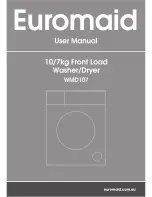
23
PROBLEM
SOLUTION
DISHES DIRTY/SUDS IN
DISHWASHER/CYCLE
NOT COMPLETE
If foam or suds are detected by the dishwasher sensing system, the dishwasher may not operate
properly or may not fill with water.
Suds can come from:
■
Using the incorrect type of detergent, such as dish detergent for hand washing dishes,
laundry detergent, or hand soap.
■
Not replacing the rinse aid dispenser cap after filling (or refilling) the rinse aid.
■
Using an excessive amount of dishwasher detergent.
■
Inadequate rinsing of detergent from dishes washed by hand before loading them into
the dishwasher.
Call for service.
If no water was present in the machine at any time during a heated wash cycle, the cycle
will end and the Complete indicator will not come on. See “Will Not Fill” in the
“Troubleshooting” section.
DID NOT SANITIZE
If the Sanitized light is blinking, the load is NOT sanitized. The cycle was interrupted in the
final rinse, or the temperature for your water heater is set too low. Set your water heater to
120ºF (49°C).
DAMAGE TO DISHWARE
Improper loading can cause dishes to become chipped or damaged. (See specific loading
instructions within this guide.)
BLINKING LIGHTS
Blinking indicators will occur when the cycle is paused or when the cycle has been
interrupted by opening the door. If the Start/Resume light is blinking, close the door
and press START/RESUME.
If the Complete light or any other lights are blinking and the dishwasher will not run, call
for service.
CLOUDY OR SPOTTED
DISHWARE (AND HARD
WATER SOLUTION)
Add or adjust the amount of liquid rinse aid for better drying and to reduce spotting. See the
“
Detergent and Rinse Aid” section.
Use the correct amount of detergent.
Confirm that the cloudiness is removable by soaking the item in white vinegar for 5 minutes. If
the cloudiness disappears, it is due to hard water. Adjust the amount of detergent and rinse aid.
See “Hard Water (White Residue on Dishwasher Interior or Glassware)” in the “Troubleshooting”
section. If it does not come clear, it is due to etching (see below).
Be sure the incoming water temperature is set at 120°F (49°C).
Try using the Hi Temp and Sani Rinse options.
To remove spotting, run a vinegar rinse through the dishwasher.
■
Wash and rinse the affected dishware and load into dishwasher. Remove all silverware
and metal items. Put 2 cups (500 mL) of white vinegar in a glass measuring cup in the
lower rack. Run a Normal Wash cycle with the Turbo Heat Dry option turned off. No
detergent is needed.
ETCHING (PERMANENT
CLOUDINESS)
This is an erosion of the surface of the glassware and can be caused by a combination of:
water that is too hot, from using too much detergent with soft water or by pre-washing.
Detergent needs food soil to act upon. If etching has occurred, the glassware is permanently
damaged. To avoid further etching, adjust the detergent amount to match the water hardness,
stop pre-washing, and use water heating options only when incoming water temperature is
below 120°F (49°C).
LEAKING WATER
Be sure dishwasher has been installed properly and is level.
Suds can cause the dishwasher to overflow. Measure the detergent accurately and use only
detergents designed for use in a dishwasher. Less detergent is needed in soft water. Try another
brand of detergent if sudsing continues.
To avoid rinse aid leaking from the dispenser, be sure the lid is securely attached and
avoid overfilling.
TUB IS DISCOLORED
High iron content in the water can discolor the tub.
Tomato-based foods can discolor the tub or dishware. Large amounts of tomato-based
foods should be removed from the dishes before loading.
A citrus-based cleaner can be used to clean.
















































